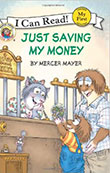Kiddynomics: An Economics Curriculum for Young Learners, Lessons for Grades Pre-K-K

Kiddynomics: An Economics Curriculum for Young Learners is a set of lessons designed to introduce young children to the economic way of thinking. Informed decision-making is a critical thinking skill that students can use throughout their school, personal, and work lives. And, as citizens in a democratic society, they should understand basic principles of how the economy operates. Beginning economic education early and building on that learning throughout students’ education is the best way to ensure they develop vital decision-making skills.
Watch a short video as 3- and 4-year-olds get a taste of personal finance education, and see what parents have to say about starting so young. Read more about the importance of teaching young children about economics and personal finance in the essay "It's Never Too Early to Start," from our 2016 annual report.
In this curriculum, students are introduced to basic personal finance and economic concepts, such as scarcity, choice, goods, services, saving, spending, and banks. They explore these concepts through popular children’s literature to reinforce reading fluency. In addition to reading integration, all lessons incorporate activities to enhance school-readiness skills, such as categorizing objects, counting, and letter recognition. Practicing these skills in a variety of contexts helps students prepare for their transition to kindergarten and beyond.
All lessons feature active-learning strategies that encourage students to ask and answer questions, participate in group discussions, and build vocabulary. Each lesson can be taught in about 45 minutes but can be easily divided into smaller segments. Songs, dramatic play, and art—all things young learners enjoy—are incorporated throughout to maintain student engagement. Finally, several extension activities are suggested at the end of each lesson to further student learning.
The lessons are aligned with kindergarten readiness skills.
Lesson 1: Betty Bunny Wants Everything

Students learn about wants, choice, and scarcity. They listen to the story Betty Bunny Wants Everything and identify all the wants that Betty Bunny has at the toy store. Students learn that because of scarcity, they must make choices. They practice making choices by selecting a treat they want, a toy for one of the book characters, and finally a school item. They sing a song about choices and scarcity.
Subjects and concepts covered in this lesson include decision-making, economics, personal finance, scarcity and wants.
(Book by Michael B. Kaplan / ISBN: 978-0-8037-3408-1)
Lesson 2: Nizzy and Cooper's ABC Adventure
In this lesson, students learn what goods and services are. They listen to the story Nizzy and Cooper’s ABC Adventure. Students categorize goods and services labeled on alphabet cards. They learn a song about goods and services, identify goods and services they use, and identify the first letter of their first or last names and draw a good or a service that starts with that letter. The extension activities provide opportunities for role-play and counting.
Subjects and concepts covered in this lesson include economics, goods/services and personal finance.
Teachers: download the story to read to your class or watch the narrated video, below.
Lesson 3: An Orange in January

Students learn about the economic concepts of consumer and producer. They give examples of consumers and producers from the book An Orange in January. They become producers by helping make orange juice popsicles and consumers when they eat the popsicles. They are asked to correctly order three pictures based on the story.
Subjects and concepts covered in this lesson include economics, personal finance and producers/consumers.
(Book by Dianna Hutts Aston / ISBN: 978-0-8037-3146-2)
Lesson 4: Just Saving My Money

Students learn about banks and money. They recognize coins as money and manipulate them with classifying, sorting, and pattern-making activities. They draw a picture in a piggy bank of a good they would like to buy, cut out the bank, and hang it in the room. They hear the story Just Saving My Money and listen for the words "money" and "bank." Finally, each student draws a self-portrait of going to a bank.
Subjects and concepts covered in this lesson include banks, economics, money, personal finance and saving.
(Book by Mercer Mayer / ISBN: 978-0-06-083557-6)
Lesson 5: Saving, Spending, and Income: Save It!

In this lesson, students learn about income, saving, and spending. They listen to the story Save It! and identify examples of when Honey is earning income, saving, and spending.
Subjects and concepts covered in this lesson include income, saving and spending.
(Book by Cinders McLeod / ISBN: 978-0-593-40621-2)
Awards
This curriculum received the 2016 Curriculum Gold Award from the National Association of Economic Educators.
Read more about our award-winning resources »
---
If you have difficulty accessing this content due to a disability, please contact us at economiceducation@stls.frb.org or call the St. Louis Fed at 314-444-8444 and ask for Economic Education.

